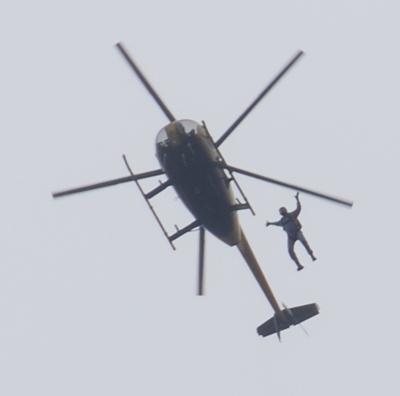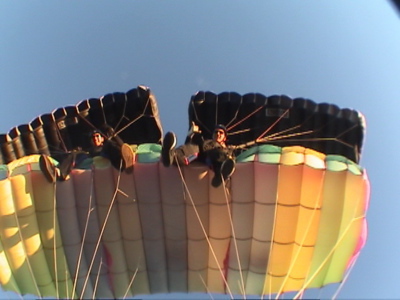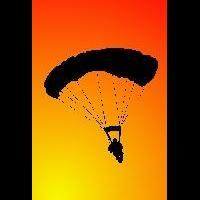QuoteGet the biggest round that will fit in the seat and fly the airplane like your life depends on it.
>>>>>>>>>>>>>>>>>>>>>>>>>>>>>>>>>>
Still sound advice ... kind of like telling a junior jumper that the best way to handle malfunctions is to pack his main neatly.
My idea of a fair fight is clubbing baby seals
CrazyL 0
No i don't work for any gear manufacturers and have no sponsors, my opinion is an objective opinion. I agree with you about the squares being reliable and such especially reliable for landing softly, given that the parachute has deployed without fail. Most pilots are'nt jumpers more than likely most have never flown a parachute. I'll get back to this later duty calls.
riggerrob 643
I a recent decision by certain military folk, new improved square on square gear was turned down in favour of round on round. One point for this decision was the reliability of rounds vs squares.
>>>>>>>>>>>>>>>>>>>>>>>>>>>>>>>>>>
If they were talking about rounds with anti-inversion nets or sombrero sliders, YES!
But anti-inversion nets are not available to civilians. A British company tried selling a round, skydiving reserve - with anti-inversion netting - about 20 years ago, but they were so bulky that hardly anyone bought them.
As for Sombrero sliders, YES! I would cheerfully buy a round canopy with a sombrero slider because it is one of the few round canopies that approaches squares in terms of reliability.
riggerrob 643
Most pilots are'nt jumpers more than likely most have never flown a parachute.
>>>>>>>>>>>>>>>>>>>>>>>>>>>>>>>>>>>>
I could quote the old paradigm at nauseum, but my opinion shifted when I worked on the P124A/Aviator.
Consider this, when is the last time USPA or CSPA approved the concept of teaching first jump courses with round parachutes?
I forget the date, but circa 1990, CSPA banned the whole concept of dropping civilian students with round mains because rounds injured too many people. The problem is that rounds pound you straight down - in light winds - which requires an above-average PLF if you want to walk away. The primary reason CSPA banned rounds for students was the high incidence of leg fractures.
On the other hand, most of the time squares approach the planet at a comparatively flat angle, striking a glancing blow, which is easily slid out.
Returning to the concept of PEPs, we should treat pilots in distress the same as civilian first jump students, i.e. give them large, docile square canopies.
>>>>>>>>>>>>>>>>>>>>>>>>>>>>>>>>>>>>
I could quote the old paradigm at nauseum, but my opinion shifted when I worked on the P124A/Aviator.
Consider this, when is the last time USPA or CSPA approved the concept of teaching first jump courses with round parachutes?
I forget the date, but circa 1990, CSPA banned the whole concept of dropping civilian students with round mains because rounds injured too many people. The problem is that rounds pound you straight down - in light winds - which requires an above-average PLF if you want to walk away. The primary reason CSPA banned rounds for students was the high incidence of leg fractures.
On the other hand, most of the time squares approach the planet at a comparatively flat angle, striking a glancing blow, which is easily slid out.
Returning to the concept of PEPs, we should treat pilots in distress the same as civilian first jump students, i.e. give them large, docile square canopies.
fcajump 164
[replyI have "demo'd" just about every canopy that has been mentioned in the thread. Trust me you don't want to go there.
This is just my opinion so take or leave it. You are flying a C-182. The chances of you needing to get out and then successfully getting out are slim. Unless you are over the Rocky Mountains at night or the plane comes apart in flight you will probably choose to stay with the aircraft. In either case you are going to be low, can’t see the ground and more than likely injured.
Get the biggest round that will fit in the seat and fly the airplane like your life depends on it.
This is just my opinion so take or leave it. You are flying a C-182. The chances of you needing to get out and then successfully getting out are slim. Unless you are over the Rocky Mountains at night or the plane comes apart in flight you will probably choose to stay with the aircraft. In either case you are going to be low, can’t see the ground and more than likely injured.
Get the biggest round that will fit in the seat and fly the airplane like your life depends on it.
As to demo'ing systems, you might talk with Sandy and see if he has an Aviator to demo. As to the rest, save your ankles.
This is NOT to say I believe in squares over rounds... as a matter of fact, that was the topic of my 2005 PIA Symp talk. When I signed up for it, I figured this was an easy talk to give a diffinitive answer to... Not so. Interviewed Sandy, Dan T, John/Nancy, Gilmore and others who have built BOTH types of systems. Even the EXPERTS who build and test these systems are not sold on square PEP's. Some are, some aren't and some are on the fence. I have one, and like it... but I recognize the limitations as well.
As to a pilot getting out of a Cessna, we have a pilot from my (old) home DZ that is still alive due to his PEP. He figured a 26' lopo was a better option that his C-206 that had no tail after an on-step deployment. However, even KNOWING what to do, it still took from 10,500' to ~4,000' for him to simply "get out and pull" due to the gyrations of the airplane. (one experienced jumper was not able to exit at all
Question for you folks... I am looking for a topic for the 2007 Symp... Of those going, would you guys spend an hour listening to and then open forum on this topic (round/square PEP)?? If so, I'll pull out my notes and update for this year. If not, I'll find something else.
Thanks,
Jim
Always remember that some clouds are harder than others...
QuoteAs to a pilot getting out of a Cessna, we have a pilot from my (old) home DZ that is still alive due to his PEP. He figured a 26' lopo was a better option that his C-206 that had no tail after an on-step deployment. However, even KNOWING what to do, it still took from 10,500' to ~4,000' for him to simply "get out and pull" due to the gyrations of the airplane. (one experienced jumper was not able to exit at all
And the average non-jumper pilot will not make the decision to leave until it is to late to do so.
It only takes about 1/2 of 1 G and you cannot stand up from a seated position.
My idea of a fair fight is clubbing baby seals






>>>>>>>>>>>>>>>>>>>>>>>>>>>>>>>>>>
Still sound advice ... kind of like telling a junior jumper that the best way to handle malfunctions is to pack his main neatly.